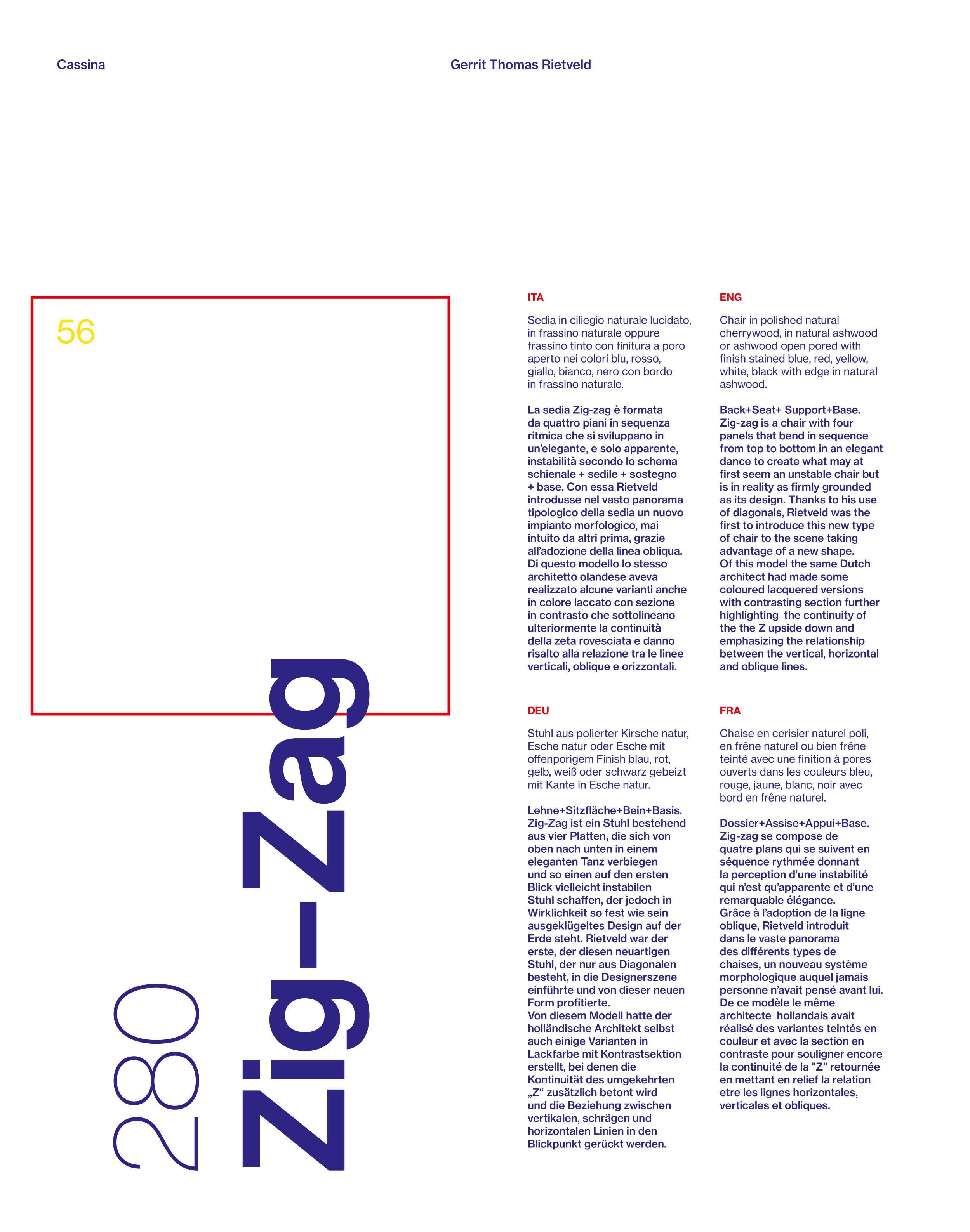280
Zig–Zag
Sedia in ciliegio naturale lucidato,
in frassino naturale oppure
frassino tinto con fi nitura a poro
aperto nei colori blu, rosso,
giallo, bianco, nero con bordo
in frassino naturale.
La sedia Zig-zag è formata
da quattro piani in sequenza
ritmica che si sviluppano in
un’elegante, e solo apparente,
instabilità secondo lo schema
schienale + sedile + sostegno
+ base. Con essa Rietveld
introdusse nel vasto panorama
tipologico della sedia un nuovo
impianto morfologico, mai
intuito da altri prima, grazie
all’adozione della linea obliqua.
Di questo modello lo stesso
architetto olandese aveva
realizzato alcune varianti anche
in colore laccato con sezione
in contrasto che sottolineano
ulteriormente la continuità
della zeta rovesciata e danno
risalto alla relazione tra le linee
verticali, oblique e orizzontali.
Stuhl aus polierter Kirsche natur,
Esche natur oder Esche mit
off enporigem Finish blau, rot,
gelb, weiß oder schwarz gebeizt
mit Kante in Esche natur.
Lehne+Sitzfl äche+Bein+Basis.
Zig-Zag ist ein Stuhl bestehend
aus vier Platten, die sich von
oben nach unten in einem
eleganten Tanz verbiegen
und so einen auf den ersten
Blick vielleicht instabilen
Stuhl schaff en, der jedoch in
Wirklichkeit so fest wie sein
ausgeklügeltes Design auf der
Erde steht. Rietveld war der
erste, der diesen neuartigen
Stuhl, der nur aus Diagonalen
besteht, in die Designerszene
einführte und von dieser neuen
Form profi tierte.
Von diesem Modell hatte der
holländische Architekt selbst
auch einige Varianten in
Lackfarbe mit Kontrastsektion
erstellt, bei denen die
Kontinuität des umgekehrten
„Z“ zusätzlich betont wird
und die Beziehung zwischen
vertikalen, schrägen und
horizontalen Linien in den
Blickpunkt gerückt werden.
Chair in polished natural
cherrywood, in natural ashwood
or ashwood open pored with
fi nish stained blue, red, yellow,
white, black with edge in natural
ashwood.
Back+Seat+ Support+Base.
Zig-zag is a chair with four
panels that bend in sequence
from top to bottom in an elegant
dance to create what may at
fi rst seem an unstable chair but
is in reality as fi rmly grounded
as its design. Thanks to his use
of diagonals, Rietveld was the
fi rst to introduce this new type
of chair to the scene taking
advantage of a new shape.
Of this model the same Dutch
architect had made some
coloured lacquered versions
with contrasting section further
highlighting the continuity of
the the Z upside down and
emphasizing the relationship
between the vertical, horizontal
and oblique lines.
Chaise en cerisier naturel poli,
en frêne naturel ou bien frêne
teinté avec une fi nition à pores
ouverts dans les couleurs bleu,
rouge, jaune, blanc, noir avec
bord en frêne naturel.
Dossier+Assise+Appui+Base.
Zig-zag se compose de
quatre plans qui se suivent en
séquence rythmée donnant
la perception d’une instabilité
qui n’est qu’apparente et d’une
remarquable élégance.
Grâce à l’adoption de la ligne
oblique, Rietveld introduit
dans le vaste panorama
des diff érents types de
chaises, un nouveau système
morphologique auquel jamais
personne n’avait pensé avant lui.
De ce modèle le même
architecte hollandais avait
réalisé des variantes teintés en
couleur et avec la section en
contraste pour souligner encore
la continuité de la "Z" retournée
en mettant en relief la relation
etre les lignes horizontales,
verticales et obliques.
ITA
ENG
DEU
FRA
56
Cassina
Gerrit Thomas Rietveld


